
Service Level Management
Centralization and Automation
Copyright and disclaimer: This study was conducted by GROHMANN BUSINESS CONSULTING on behalf of amasol GmbH. The data and information contained therein were determined with the greatest care. Nevertheless, no liability can be assumed for their completeness and accuracy.
All rights to the content of the study are held by amasol GmbH. Reproductions and publications – also in extracts – are only permitted with the written consent of amasol GmbH.
Disclaimer: The reproduction of common names, trade names, product designations, etc. in this work, even without special identification, does not give rise to the assumption that such names would be considered free within the meaning of trademark and brand protection legislation and may therefore be used by anyone. References in this work to any specific commercial product, process or service by trade name, trademark, manufacturer’s designation, etc. do not imply endorsement or favoring in any way.).
Technical Data: 123 participants from German companies took part in the trend study “Service Level Management -Centralization and Automation” by completing an online questionnaire. The participation was anonymized in the months of January to March 2023. After the evaluation, all questionnaires and evaluation documents were destroyed or deleted.
All results have been rounded to whole percentages. Therefore, it is possible that the percentages given do not add up to exactly 100 percent.
Foreword
Service Level Management (SLM) is increasingly becoming an essential part of the IT infrastructure. However, manual monitoring of SLM processes is a time-consuming and error-prone task that impacts productivity. For this reason, SLM automation is increasingly coming into focus.
The aim of the trend study “Service Level Management – Centralization and Automation” was to find answers to questions such as:
– What role does centralized or automated management of service level agreements (SLAs) currently play in German companies?
– What goals are to be achieved with centralized or automated service level management?
– What are the obstacles and hurdles to centralized or automated service level management?
– How is service level management currently implemented technically (processes, software)?
– What are the future plans for service level management?
We would like to take this opportunity to thank the participants once again for their support, and wish everyone else an interesting read with hopefully important insights and suggestions for their own daily work.
Munich, May 2023
amasol GmbH
(www.amasol.de)
Summary
Below you will find an overview of the most important results of the trend study “Service Level Management – Centralization and Automation”:
Service Level Management – Meaning
For 28 percent of respondents, the topic of service level management is already of central or high importance. A further 43 percent have at least already addressed the issue. In just under a quarter of the companies (24%), on the other hand, the topic of service level management does not (yet) play any role.
The most frequently cited benefits of centralized or automated service level management were:
– Better relationship management with all stakeholders involved (65 %)
– Better performance management (63%)
– Better risk management (51%)
– Continuous Improvement (50 %)
The most frequently cited obstacle/barrier to the introduction of automated service level management was the lack of flexibility/scalability of the existing solution or process (35%). This was followed by other priorities (34%) and the fact that there are only simple SLAs in the company.
Service Level Management – Implementation
Slightly more than half of the respondents (56%) stated that there is not yet an established process for service level management in the company.
Likewise, 56 percent of the survey participants do not yet use any special software for service level management.
Availability (89%) is the Key Performance Indicator (KPI) most frequently measured across the SLM software solutions deployed in the companies surveyed. This is followed by resolution rate (81%) and deployment time (74%).
Service level management – Future planning
More than half of the survey participants (54%) say they are in the process of continuously developing SLA reporting in the company (26%) or optimizing the process for service level management (28%). One in ten survey participants stated that there are plans to establish centralized service level management in the near future.
At the end of this results report, Frank Jahn, member of the management board and CSO of amasol GmbH, comments on the results of the trend study “Service Level Management”
Results
At the beginning of the survey for the “Service Level Management” trend study, the size of the company and the sector of the company for which the respondent works were queried. In addition, questions were asked about their position in the company.
Information about the participants
Size of the company

Company branch
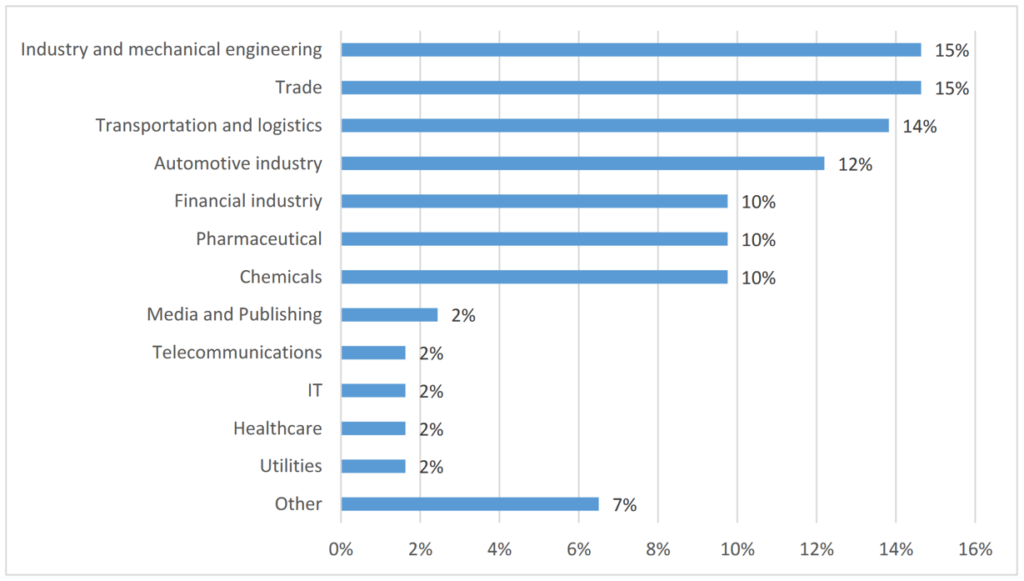
Named under “Other” were: Customer Service Management (Call Center), Services, Glass Finishing, Sportswear Retail, Textile, Defense & Space, Administration.
Position in the company
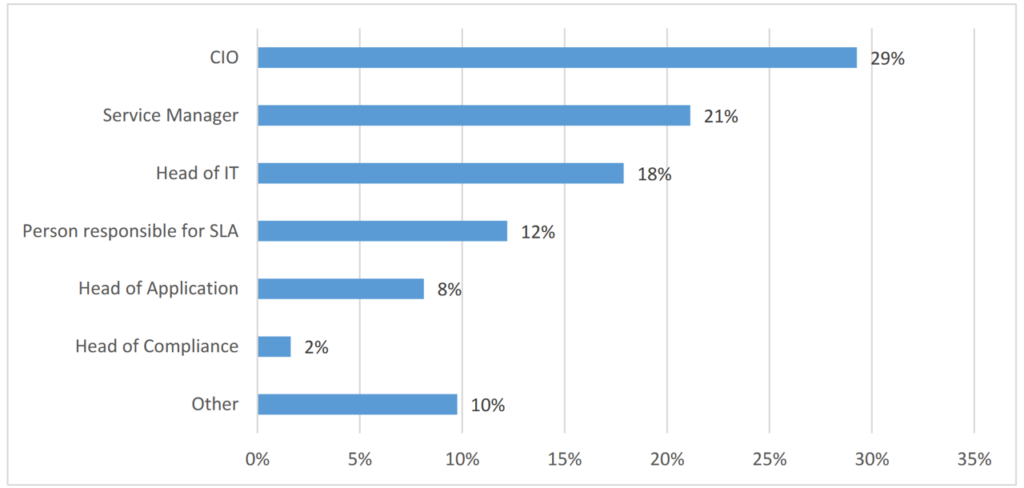
The following were named under “Other”: In-house Consultant SAP Services, Technical Delivery Manager & Group IT PMO, Team Leader License Management, Head of Operations, Program Director, SIAM Provider Manager, Head of Service Desk, Team Leader SAP Basis, Platform Owner ITSM, Team Leader IT Controlling, Customer Success Manager, n.a.
Service Level Management – Meaning
The first part of the trend study dealt with the importance that respondents attach to the topic of service level management in their companies.
To begin, survey participants were asked to complete the following sentence:
The centralized or automated management of the service level agreements existing in our company, the so-called SLA management (including operational level agreements (OLA) and supplier agreements (underpinning contracts (UC)), …
For 28 percent of respondents, the topic of service level management is already of central or high importance. A further 43 percent have at least already addressed the issue. In just under a quarter of the companies (24%), on the other hand, the topic of service level management does not (yet) play any role.
The survey participants were then asked what advantages they generally associate with centralized or automated service level management.
What advantages do you associate with centralized or automated service level management?
The most frequently cited benefits of centralized or automated service level management were:
1. Better relationship management with all stakeholders involved (65 %)
2. Better performance management (63%)
3. Better risk management (51%)
4. Continuous Improvement (50 %)
5. Named under “Other” were:
– Fewer incidents
– Cost reduction
– More transparency for cost drivers
– Control tool for service providers
How do you rate the importance of automated service level management for IT performance and IT stability in your company?
A quarter of the respondents (25%) attribute central importance to automated service level management for IT performance or IT stability in the company. A further 44% rate the importance as high. In contrast, one in five survey participants (20%) rated the importance as low.
To conclude this part of the “Service Level Management” trend study, we asked about the obstacles and hurdles that exist when introducing centralized service level management.
What obstacles/barriers are currently preventing the introduction of automated service level management in your company?
The most frequently cited obstacle/barrier to the introduction of automated service level management was the lack of flexibility/scalability of the existing solution or process (35%). This is followed by other priorities (34%) and the fact that there are only simple SLAs in the company (34%).
Specified under “Other” were:
– Complexity
– Complexities of the contracts
– Existing capacities of implementation
– Complex IT systems and thus difficult recording of SLA components
Service Level Management – Implementation
This part of the trend study focused on the question of the extent to which the companies surveyed have already pushed ahead with centralization and automation of service level management.
To get started, the survey asked whether the companies already had an established process for service level management.
Does your company have an established process for service level management?
Slightly more than half of the respondents (56%) stated that there is not yet an established process for service level management in the company.
In the next question, those survey participants who have an established SLM process within the company were asked to indicate which SLA types are covered by it.
What type of SLAs does it currently cover? (n = 54)
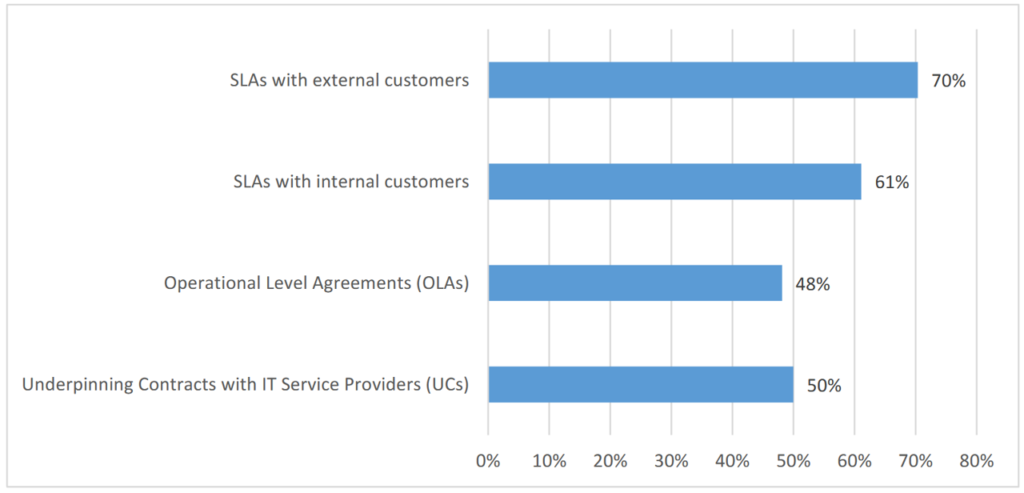
The survey also asked whether service level management is performed internally within the company or outsourced to an external service provider.
How is service level management currently implemented? (n = 54)
Nearly 60 percent of respondents said that service level management for both SLAs with customers and underpinning contracts with IT service providers is performed internally within the company.
The survey also revealed that service level management for SLAs with customers is outsourced to an IT service provider twice as often (30%) as service level management for underpinning contracts with IT service providers. Under “Other”, it was stated that SLAs are partly determined and managed internally and partly externally.
The next question dealt with the use of a special software solution for service level management.
Do you use special software for service level management?
Fifty-six percent of respondents said they do not currently use any specific software for service level management in the company.
As a complement to the question about SLM software, those using a solution were asked what type of software solution it was.
What type of software do you use for service level management? (n = 54)
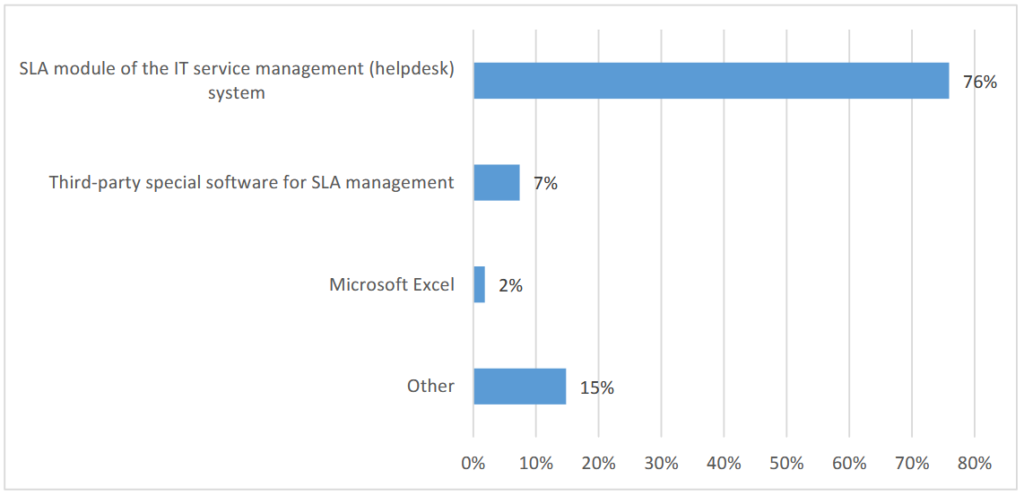
In more than three quarters of the companies surveyed (76%), the SLA module of the IT service management system is used for service level management. Seven percent of the survey participants stated that they use third-party special software.
Under “Other” were named (in case of multiple naming, number of namings in parentheses):
– ServiceNow (3)
– Matrix42
– Cherwell
– All previously listed options
– Various
Respondents who selected the “Third-party specialized software for SLA management” option mentioned the following solutions:
– ServerGuard, internal solutions
– ivanti Service Manager, checkmk
– Archer
– Broadcom BSI
Finally, survey participants who use an SLM software solution were asked to indicate which KPIs are monitored with it.
Which KPIs are measured via the solution? (multiple selection possible) (n = 54)
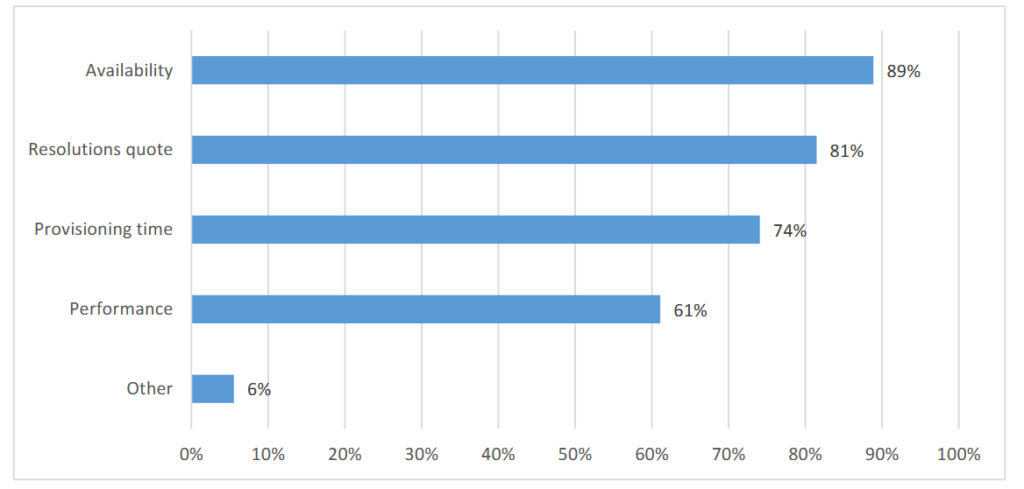
Availability is the KPI most frequently measured via the SLM tools (89%). It is followed by resolution rate (81%) and provisioning time (74%).
Specified under “Other” were:
– Incident, Problem and Change Management
– Recovery
– Call Center, File Transmission
Service level management – Future planning
At the end of the survey for the trend study, the focus was on future plans in the area of service level management.
What are your future plans in the area of SLA management?
More than half of the companies surveyed (54%) are in the process of continuously developing their SLA reporting (26%) or optimizing the process for service level management (28%). One in ten survey participants stated that there are plans to establish centralized service level management in the near future. In one in five companies, on the other hand, there are currently no concrete plans in the area of service level management.
Finally, the survey asked who in the companies is responsible for the topic of service level management.
Who is responsible for service level management in your company?
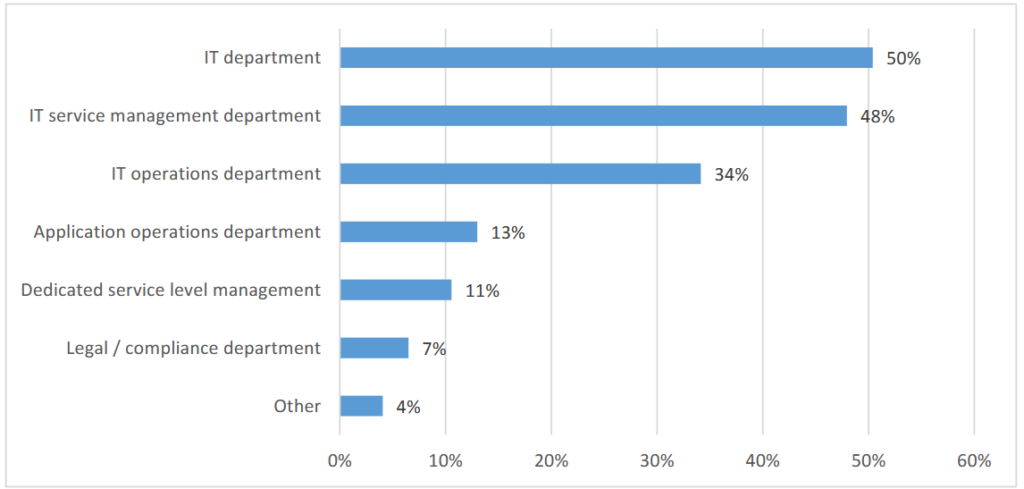
Named under “Other” were:
– Product Management
– Management decision
– Vendor Management
– Supplier Management
Finally, the survey participants were able to make a freely formulated statement on the subject of service level management:
// “Service level management is very important and will be rolled out soon – currently the priorities are more in cybersecurity.”//
// “I believe that SLA, OLA and automation are a continuous improvement process in terms of tools, software and techniques. It’s very important and it’s always at the heart of the team.”//
Interview on the results of the “Service Level Management” trend study
The digital transformation is in full swing: Companies are saying goodbye to outdated processes and are successful with digital business models – if the IT behind it works! amasol supports companies in properly measuring, optimizing and agilizing the performance of their IT services.
In the following interview, Frank Jahn, member of the management board and CSO of amasol GmbH, comments on the results of the trend study “Service Level Management”.
Question: You commissioned a survey on the subject of service level management for the first time. Can you briefly explain what goals you were pursuing with it?
Jahn: The topic of service level management in general is anything but new. However, in times when “cloud first” is becoming a central component of the IT sourcing strategy in more and more companies, the dependence on external service providers is also increasing dramatically. For this reason, the survey aimed to find out how relevant the topic of service level management currently is in German companies and whether its importance is tending to increase in the sign of “cloud first”.
Question: For 28 percent of respondents, the topic of service level management is already of central or high importance. A further 43 percent have at least already addressed the issue. In just under a quarter of the companies (24%), on the other hand, the topic of service level management does not (yet) play any role. How do you rate this result?
Jahn: What I find surprising is the generally high level of maturity in the area of service level management. More than 70 percent deal with this topic in their daily work. However, I am surprised that almost a quarter of the companies surveyed do not attach any relevance to this topic. This raises the question of whether trust in the service provider is replacing control in these cases, or whether the result simply reveals a lack of knowledge about efficient methods in service level management. I myself am convinced that the lack of modern software solutions for automating service level management has also played a role in this.
Question: “Better relationship management with all involved stakeholders”, “Better performance management” and “Better risk management” were most frequently mentioned as advantages of centralized or automated service level management. Do these statements match your project experience?
Jahn: I can fully confirm that. On the service delivery side, it has become established that a detailed monthly report on the respective service level agreement is prepared for the most important stakeholders. SLA violations are commented on and, in the case of correspondingly business-critical contracts, bonus/malus regulations are applied.
Organizations that have succeeded in professionalizing communication with their customers via SLAs see another major advantage in the image boost that this brings. Other organizations control the optimization of their IT infrastructure by analyzing the availability and/or performance figures collected by means of service level management. In some cases, this goes so far that management salary bonuses are linked to compliance with SLAs.
Question: The most frequently cited obstacle to implementing automated service level management was the lack of flexibility/scalability of the existing solution or process. How can companies overcome this obstacle?
Jahn: In most organizations, SLA reporting is a labor-intensive process. Therefore, many try to limit this high effort only to the large/important customers. On the other hand, people know that high service quality leads to a good image and possibly even to competitive advantages. In this area of tension we as amasol see an opportunity. With our experience from more than 15 years of consulting in the SLM environment, we have now decided to develop a modern software product for the automation of service level management. The goal is to increase the efficiency of SLA reporting and to offer it as a standard for as many IT services as possible.
Question: Slightly more than half of the respondents (56%) stated that there is not yet an established process for service level management in the company. The same number of survey participants stated that they do not yet use a special software solution for service level management. How do you rate this result?
Jahn: This confirms that SLA management and reporting can be very time-consuming and that many people shy away from it. That’s why we place so much emphasis on maximizing the degree of automation of SLA reporting. Our pilot customer, who has already achieved a high level of automation over the last ten years, appreciates the further development and performance of our solution.
I think if more was known about how easy and lean SLA management can be set up, it would change the numbers. We are working to increase confidence in SLA management. It’s clear that many organizations already have basic service level management in place. But I think that this topic permanently needs some attention and further development. We want to make a contribution here and are already getting very positive feedback from our pilot customers. We therefore believe that the SLM potential is far from exhausted.
Question: More than half of the companies surveyed (54%) are in the process of continuously developing their SLA reporting (26%) or optimizing the process for service level management (28%). One in ten survey participants indicated that there are plans to establish centralized service level management in the near future. What advice can you give these companies when it comes to establishing central service level management or optimizing the existing SLM system?
Jahn: The responses on the future of service level management in this study confirm our market observation and forecast that the relevance of the topic of SLM will continue to increase. My tip for successfully implementing comprehensive service level management is to ensure that the agreed SLAs are firstly measurable and secondly not too complicated. Furthermore, a guaranteed performance indicator increases the image gain if it is proven that it has been achieved. In general, the results must be traceable. No customer accepts “watermelon SLAs”. I know of a case in practice where a large IT
organization has concluded SLAs for over 3,000 services and is now managing them successfully. In my opinion, you can achieve a lot with automation.
Question: Finally, a personal conclusion on the results of the “Service Level Management” trend study: Was there one result that particularly surprised you?
Jahn: I found it very exciting that provisioning time was named as the third most important measurement criterion. In my opinion, this shows how much the large cloud providers have already influenced the expectations of customers, but also that IT organizations must meet these expectations – namely by monitoring and documenting precisely this key figure.
Discover more about amasol

Our expertise
Benefit from over 25 years of deep expertise and high-quality service delivery across our key areas

Resource center
Search through our library of resources for inspiration on how amasol has helped other customers to power their experience business.

Our tools
Explore the tools and partnerships that help us drive success and optimize your IT environment.

Why amasol
We aim to increase agility, increase the value proposition and improve the efficiency of IT and thus increase business success.
amasol
Additional Resources
Legal Information

MUNICH
Campus Neue Balan
Claudius-Keller-Straße 3B,
81669 Munich, Germany

VIENNA
Gertrude-Fröhlich-Sandner-Str. 2-4, Tower 9,
1100 Vienna, Austria

NEW DELHI
13/24 2ND FLOOR
West Patel Nagar New Delhi
110008 India

LONDON
60 St Martins Lane Covent Garden,
London, WC2N 4JS, United Kingdom
